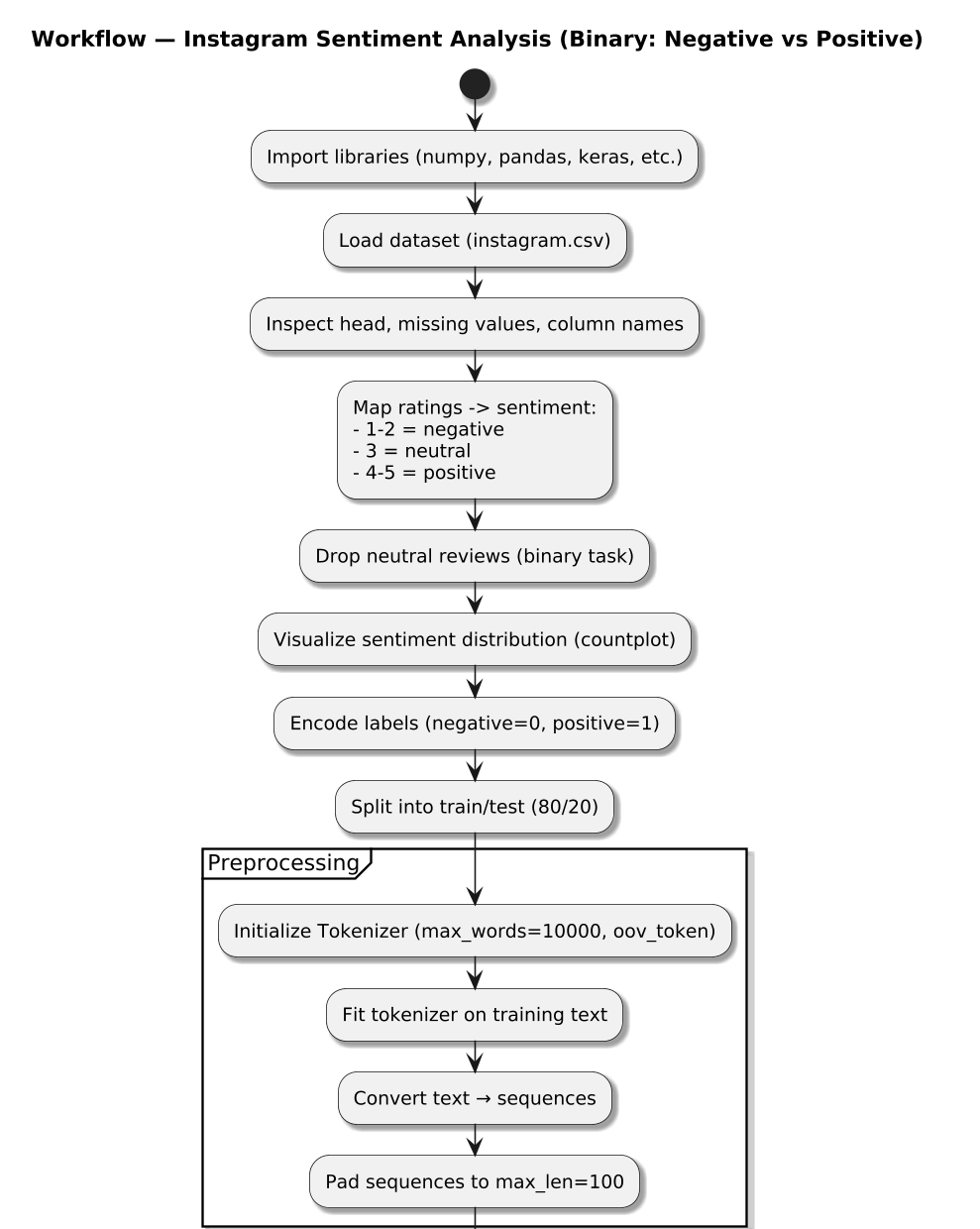Deep Learning Based Sentiment Analysis on Instagram Insights of Consumer Behavior for Improving Business Decision Making
Keywords:
Sentiment Analysis, Consumer Behavior, BiLSTM, BERT, DistilBERT, Social Media Analytics, Contextual EmbeddingsAbstract
The increasing use of social media platforms such as Instagram has made them a significant source of consumer insights for businesses, highlighting the importance of automated sentiment analysis. This study aims to address the challenge of accurately classifying consumer sentiments in Instagram posts, where informal language, slang, and sarcasm often reduce the effectiveness of traditional models. To overcome this gap, two deep learning approaches were employed: a Bidirectional Long Short-Term Memory (BiLSTM) network as a classical recurrent baseline and transformer-based architectures (BERT and DistilBERT) as state-of-the-art models. A dataset of 184,010 Instagram posts was preprocessed, tokenized, and mapped into positive and negative sentiments, and the models were trained and evaluated using accuracy, precision, recall, F1-score, ROC-AUC, and confusion matrices. The results demonstrated that BERT achieved the highest performance with an accuracy of 0.91 and an F1-score of 0.91, outperforming BiLSTM (accuracy 0.87, F1-score 0.86), while DistilBERT provided a competitive balance between accuracy (0.89) and efficiency. These findings confirm that transformer-based models, particularly BERT, are better suited for capturing nuanced sentiments in social media text. The study concludes that models can provide actionable insights into consumer behavior, enabling businesses to enhance brand monitoring and customer engagement.
References
D. G. Mohamed AbdelFattah, “A Sentiment Analysis Tool for Determining the Promotional Success of Fashion Images on Instagram,” Int. J. Interact. Mob. Technol., vol. 11, no. 2, p. 4, 2017, doi: https://doi.org/10.3991/ijim.v11i2.6563.
F. D. Zenun Kastrati, “Sentiment Analysis of Students’ Feedback with NLP and Deep Learning: A Systematic Mapping Study,” Appl. Sci, vol. 11, no. 9, p. 3986, 2021, doi: https://doi.org/10.3390/app11093986.
N. Al-Twairesh, H. Al-Khalifa, A. Al-Salman, and Y. Al-Ohali, “AraSenTi-Tweet: A Corpus for Arabic Sentiment Analysis of Saudi Tweets,” Procedia Comput. Sci., vol. 117, pp. 63–72, 2017, doi: https://doi.org/10.1016/j.procs.2017.10.094.
M. N. M.-G. Nhan Cach Dang, “Sentiment Analysis Based on Deep Learning: A Comparative Study,” Electronics, vol. 9, no. 3, p. 483, 2020, doi: https://doi.org/10.3390/electronics9030483.
M. Wankhade, A. C. S. Rao, and C. Kulkarni, “A survey on sentiment analysis methods, applications, and challenges,” Artif. Intell. Rev., vol. 55, no. 7, pp. 5731–5780, Oct. 2022, doi: 10.1007/S10462-022-10144-1/METRICS.
N. P. Pavitra Sankar, “Sentiment Analysis on Twitter Data for Depression Detection,” J. Logist. Informatics Serv. Sci., vol. 11, no. 3, pp. 21–36, 2024, doi: 10.33168/JLISS.2024.0302.
M. Velmala, S. Rajiakodi, K. Pannerselvam, and B. Sivagnanam, “Multimodal Sentiment Analysis of Online Memes: Integrating Text and Image Features for Enhanced Classification,” Procedia Comput. Sci., vol. 258, pp. 355–364, 2025, doi: https://doi.org/10.1016/j.procs.2025.04.272.
M. A. A. Md. Mostafizer Rahman, Ariful Islam Shiplu, Yutaka Watanobe, “RoBERTa-BiLSTM: A Context-Aware Hybrid Model for Sentiment Analysis,” IEEE Trans. Emerg. Top. Comput. Intell., vol. 5, 2025, [Online]. Available: https://arxiv.org/abs/2406.00367
L. Labudová, “Current Leading Social Media Platforms Used by Marketers and its Benefits,” Eur. Conf. Soc. Media, vol. 11, no. 1, 2024, doi: https://doi.org/10.34190/ecsm.11.1.2383.
R. M. Farhad Mortezapour Shiri, Thinagaran Perumal, Norwati Mustapha, “A Comprehensive Overview and Comparative Analysis on Deep Learning Models: CNN, RNN, LSTM, GRU,” J. Artif. Intell., vol. 6, no. 1, p. 3, 2025, doi: https://doi.org/10.48550/arXiv.2305.17473.
Y. Z. Chuanlong Yin, “A Deep Learning Approach for Intrusion Detection Using Recurrent Neural Networks,” IEEE Access, vol. 5, no. 10, 2017, doi: 10.1109/ACCESS.2017.2762418.
D. D. W. Rosa Eliviani, “Exploring Sentiment Trends: Deep Learning Analysis of Social Media Reviews on Google Play Store by Netizens,” Int. J. Adv. Data Inf. Syst., vol. 5, no. 1, p. 3, 2024, [Online]. Available: https://ijadis.org/index.php/ijadis/article/view/1318
H. W. Tao Fan, “Multimodal sentiment analysis for social media contents during public emergencies,” J. Data Inf. Sci., vol. 6, 2023, [Online]. Available: https://reference-global.com/article/10.2478/jdis-2023-0012
G. Gautam and D. Yadav, “Sentiment analysis of twitter data using machine learning approaches and semantic analysis,” 2014 7th Int. Conf. Contemp. Comput. IC3 2014, pp. 437–442, 2014, doi: 10.1109/IC3.2014.6897213.
K. Devlin, J., Chang, M. W., Lee, K., & Toutanova, “BERT: Pre-training of Deep Bidirectional Transformers for Language Understanding,” Proc. NAACL-HLT, 2019.
Y. Z. Zhesheng Jin, “A Graph Neural Network-Based Context-Aware Framework for Sentiment Analysis Classification in Chinese Microblogs,” Mathematics, vol. 13, no. 6, p. 997, 2025, doi: https://doi.org/10.3390/math13060997.
M. A. Abdalwali Lutfi, “Drivers and impact of big data analytic adoption in the retail industry: A quantitative investigation applying structural equation modeling,” J. Retail. Consum. Serv., vol. 70, p. 103129, 2023, doi: https://doi.org/10.1016/j.jretconser.2022.103129.
M. K. Aizaz Ali, “Sentiment Analysis of Low-Resource Language Literature Using Data Processing and Deep Learning,” Comput. Mater. Contin., vol. 79, no. 1, 2022, [Online]. Available: https://www.techscience.com/cmc/v79n1/56321
W. H. Dongming Wu, “Language Prompt for Autonomous Driving,” Proc. AAAI Conf. Artif. Intell., vol. 39, no. 8, 2025, [Online]. Available: https://ojs.aaai.org/index.php/AAAI/article/view/32902
A. A.-L. Noemi Merayo, “Machine learning and natural language processing to assess the emotional impact of influencers’ mental health content on Instagram,” PeerJ Comput. Sci., vol. 10, no. 9, 2024, [Online]. Available: https://peerj.com/articles/cs-2251/
D. I. M. S. Tristyanti Yusnitasari, “Sentiment Analysis of Comments on Instagram Gramedia Pustaka Accounts (GPU) Using Lexicon Based and Naive Bayes Classifier Methods,” Int. Res. J. Adv. Eng. Sci., vol. 7, no. 1, pp. 38–43, 2022, [Online]. Available: https://irjaes.com/wp-content/uploads/2022/01/IRJAES-V7N1P63Y21.pdf
J. Shobana and M. Murali, “An Improved Self Attention Mechanism Based on Optimized BERT-BiLSTM Model for Accurate Polarity Prediction,” Comput. J., vol. 66, no. 5, pp. 1279–1294, May 2023, doi: 10.1093/COMJNL/BXAC013.
M. W. & A. C. S. Rao, “Opinion analysis and aspect understanding during covid-19 pandemic using BERT-Bi-LSTM ensemble method,” Sci. Rep., vol. 12, no. 17095, 2022, [Online]. Available: https://www.nature.com/articles/s41598-022-21604-7
P. Tiwari, D. Upadhyay, B. Pant, and N. Mohd, “Twitter Sentiment Analysis Using Machine Learning and Deep Learning,” Smart Innov. Syst. Technol., vol. 311, pp. 617–628, 2023, doi: 10.1007/978-981-19-3571-8_57.
Y. D. Wenxuan Zhang, “Sentiment Analysis in the Era of Large Language Models: A Reality Check,” Assoc. Comput. Linguist., pp. 3881–3906, 2024, [Online]. Available: https://aclanthology.org/2024.findings-naacl.246/
K. K. Bibi Saqia, “Deep Learning-Based Identification of Immoral Posts on Social Media Using Fine-tuned Bert Model,” Int. J. Data Informatics Intell. Comput., vol. 3, no. 4, 2024, [Online]. Available: https://ijdiic.com/index.php/research/article/view/143

Downloads
Published
How to Cite
Issue
Section
License
Copyright (c) 2025 50sea

This work is licensed under a Creative Commons Attribution 4.0 International License.




















